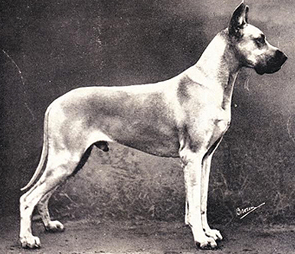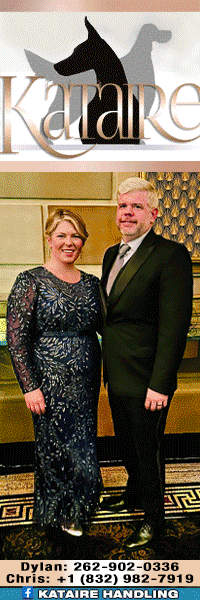Alamo Great Danes – Casting a Giant Shadow on the Sport
244 – June 2017
 The role of money in this game is undeniable. Equally true is the somewhat underrated fact that it only gets you so far. That perpetually underestimated piece of the equation is the only way to explain the endless track- record of spectacular derailments proving its limitations. People never seem to stop trying.
The role of money in this game is undeniable. Equally true is the somewhat underrated fact that it only gets you so far. That perpetually underestimated piece of the equation is the only way to explain the endless track- record of spectacular derailments proving its limitations. People never seem to stop trying.
Even during the Great Depression there were quite enough well padded bank accounts to forge new paths of self-destruction like Alamo Great Danes founded by Mrs. H.W. York back in 1937. Al- though it followed the above-mentioned script, this particular dis- aster impressively managed to highlight two money-fueled, bad ideas brewing in the dog world at the time.
The common theme uniting these plans was the longstanding controversy about imports dominating America’s dog scene. That, of course, was true from the start. How and when it became per- ceived as a problem varied by breed. Generally, the relative mag- nitude of that issue hinged on popularity. The most high profile examples were Wires and Pekes where competition was pretty much defined by invincible imports with staggering price tags. However, they were far from the only breeds that were best avoided unless money was no object.
This situation became especially notorious in Great Danes for a few reasons; starting with the joys of raising giant breeds in the dark ages of kennel management when basic stuff like parasite con- trol and disease prevention was a long way from being safe or re- liable. Feeding a Dane litter still costs a fortune but that was only half the battle when nutrition was poorly understood and vitamin deficiencies wreaked havoc on fast growing puppies. Likewise, the genetic complexity of color breeding was somewhat a mystery. Then there was ear cropping. Essentially, building and sustaining a Great Dane breeding program required nerves of steel and masochistic tendencies. In comparison, Germany was a Great Dane shopper’s paradise. Top quality stock had always been abundant but the country’s economic uncertainties put lots of otherwise un- attainable dogs on the market during the 1930s.
AKC recognized the breed in 1887, and by the early 1900s Great Danes ranked among the most popular breeds, and as artist, author, and Dane breeder Ernest Hart noted in This Is the Great Dane, competition was fierce. “During these years, as the Great Dane climbed the ladder of popularity, the records show that breeders and fanciers, eager for nothing but the best, imported, mostly from Germany.” Over a third of the 93 Danes that earned championships by 1920 were imports. “From 1920 to 1935 a total of 163 Danes won titles and of this number 78 were imports.” Of the 77 cham- pions finished from 1935 to 1940, 44 were imports.
It wasn’t just that German imports earned an increasingly high percentage of AKC titles; they overwhelmingly monopolized the specials ring. It sent a very clear and discouraging message to the average hobby breeder attempting to do it the old-fashioned way. They not only lacked the resources to acquire dogs of that caliber, but they rarely got access to them for breeding. As Norman Hank- inson noted in the March 1935 Gazette, “The outstanding criticism of American breeders is that when one considers the number of dogs which have been brought to this country, bringing with them all the best of the world’s bloodlines, one cannot avoid being dis- appointed at the infrequency with which those bloodlines have
Click here to read the complete article244 – June 2017
Short URL: http://caninechronicle.com/?p=126751
Comments are closed











